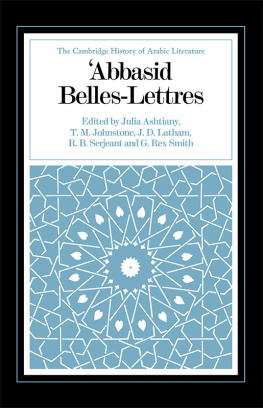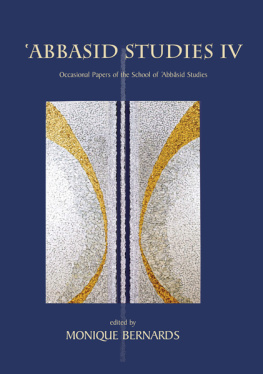Ashtiany Julia (EDT) - Abbasid Belles Lettres
Here you can read online Ashtiany Julia (EDT) - Abbasid Belles Lettres full text of the book (entire story) in english for free. Download pdf and epub, get meaning, cover and reviews about this ebook. year: 1990, publisher: CambridgeUP, genre: Art. Description of the work, (preface) as well as reviews are available. Best literature library LitArk.com created for fans of good reading and offers a wide selection of genres:
Romance novel
Science fiction
Adventure
Detective
Science
History
Home and family
Prose
Art
Politics
Computer
Non-fiction
Religion
Business
Children
Humor
Choose a favorite category and find really read worthwhile books. Enjoy immersion in the world of imagination, feel the emotions of the characters or learn something new for yourself, make an fascinating discovery.
- Book:Abbasid Belles Lettres
- Author:
- Publisher:CambridgeUP
- Genre:
- Year:1990
- Rating:3 / 5
- Favourites:Add to favourites
- Your mark:
- 60
- 1
- 2
- 3
- 4
- 5
Abbasid Belles Lettres: summary, description and annotation
We offer to read an annotation, description, summary or preface (depends on what the author of the book "Abbasid Belles Lettres" wrote himself). If you haven't found the necessary information about the book — write in the comments, we will try to find it.
Abbasid Belles Lettres — read online for free the complete book (whole text) full work
Below is the text of the book, divided by pages. System saving the place of the last page read, allows you to conveniently read the book "Abbasid Belles Lettres" online for free, without having to search again every time where you left off. Put a bookmark, and you can go to the page where you finished reading at any time.
Font size:
Interval:
Bookmark:
THE CAMBRIDGE HISTORY OF ARABIC LITERATURE
ABBASID BELLES-LETTRES
ABBASID BELLES-LETTRES
EDITED BY
JULIA ASHTIANY, T. M. JOHNSTONE , J. D. LATHAM, R. B. SER JEANT and G. REX SMITH

CAMBRIDGE UNIVERSITY PRESS
Cambridge, New York, Melbourne, Madrid, Cape Town, Singapore, So Paulo, Delhi
Cambridge University Press
The Edinburgh Building, Cambridge CB2 8RU, UK
Published in the United States of America by Cambridge University Press, New York
www.cambridge.org
Information on this title: www.cambridge.org/9780521240161
Cambridge University Press 1990
This publication is in copyright. Subject to statutory exception and to the provisions of relevant collective licensing agreements, no reproduction of any part may take place without the written permission of Cambridge University Press.
First published 1990
This digitally printed version 2008
A catalogue record for this publication is available from the British Library
Library of Congress Cataloguing in Publication data
Abbasid belles-lettres.
(The Cambridge history of Arabic literature)
Bibliography.
Includes index.
1. Arabic literature7501258History
and criticism. I. Ashtiany, Julia.
II. Series.
PJ7530.A18 1990 8927090034 82-23528
ISBN 978-0-521-24016-1 hardback
ISBN 978-0-521-08865-7 paperback
EDITORIAL PREFACE
This volume of the Cambridge History of Arabic Literature covers the literary production of a period of five centuries, from the accession of the Abbasids in 132/750 to the dynastys end and the capture of its capital, Baghdad, by the Mongols in 656/1258. Geographically, the regions covered are those actually or nominally held by the Abbasids during part or most of this period: Iraq, Syria and Iran; Egypt and the Arabian peninsula. The scope of the volume appears self-explanatory, but a few words of clarification are nevertheless called for. The term Abbasid is neither a political nor a strictly chronological designation, but a cultural one: though the first century of Abbasid rule set its stamp on a literature, that literature was thereafter to develop independently of the regime in many regional centres. Moreover, many features or tributaries of Abbasid literature had their origins in an earlier period, and are treated here within the framework of that period where appropriate. But above all the use of the term belles-lettres requires explanation. The companion to this volume, Religion, Learning and Science in theAbbasid Period, deals with Abbasid writings on such subjects as grammar, philosophy, history and law. This division between belles-lettres and technical literature is not found in Abbasid authors themselves, and could not be strictly observed in the present volume without presenting a distorted picture of the output of a given writer or region; but for a fuller treatment of the development of technical or scholarly disciplines, the reader is referred to the companion volume.
The proliferation of both scholarly and belles-lettristic genres marks a striking difference between Abbasid literature and the Arabic literature which preceded it. No less striking is the high proportion of non-Arabs who contributed to the Arabic literature of the Abbasid period, and the learned and allusive stamp of the literature as a whole. Cosmopolitan, urban Abbasid writers were conscious of the distance which separated them from the classical models by which they defined Arab and Muslim culture: archaic bedouin poetry and the enduring human and aesthetic values they believed it to embody; early Islamic history, which could be seen, no less than the Qurn itself, as enshrining the fundamental choices set before believers. These models were pressed into service to vindicate a civilization which faced rival cultural influences and claims, and which was itself in the process of absorbing many new elements. The pervasiveness of literary, Quranic and historical allusion in Abbasid writing, and the impressive growth of scholarly and critical writing side by side with belles-lettres, reflect a culture sustained by active and creative reference to tradition. It follows that modern readers must acquire some familiarity with that tradition in order to gain access to Abbasid literature even at the simplest level; and this volume has tried to provide the general reader with such an introduction by quoting original material wherever possible.
In format, the volume consists of juxtaposed studies of individual authors and thematic surveys of genres, arranged as far as possible chronologically in two main sections, prose and poetry, with each section prefaced by a general introductory chapter. These sections illustrate the literatures of Iraq and Syria, the earliest and major centres of Abbasid culture. Two chapters on the regional literatures of Egypt and the Yemen, which until recently have received less widespread attention, conclude the volume. As the type and arrangement of material reflect some characteristics of, or problems raised by, Abbasid literature, a final word should be said on this subject. The printing of texts in scholarly editions began only in the last century, and the literature is not yet well enough mapped, in terms of the sum of its productions, the finer categorizations applied to them or the relative importance of all but the most outstanding figures, to supply us with a canonical framework for interpretation. Definitive editions of many authors are not yet available, attributions are sometimes uncertain, and many texts were by their nature fluid and might be altered several times by the author himself without producing a definitive version. In addition, while there are anecdotal and biographical sources for the lives of most Abbasid men of letters, the aim of medieval biographers was not to lay bare the souls of their subjects nor even to give an exhaustive account of their careers. Thus only in exceptional cases can the lives and literary personalities of Abbasid writers be convincingly portrayed in modern biographical terms; hence one reason for the alternation in this volume between individual and general studies. But no less important is the fact that the Abbasid conception of character, whether personal or literary, is probably not to be approached in modern terms. Many writers will be found, in the following chapters, as competent practitioners of genres which have little in common and might appear to have less common ground in the writers own personality than in the requirements of his patrons. An explanation must be sought both in the conditions of literary production and in Abbasid conceptions of literature itself, whose variety is perhaps most broadly illustrated in the surveys of the literatures of Egypt and the Yemen, in which the links between genres, whether technical or belles-lettristic, are brought to the fore.
In the hope that the volume may be of interest and use to readers with no knowledge of Arabic as well as to Arabists, references have been given wherever possible to material which has been translated into a European language. Similarly the bibliographies, which are not intended as exhaustive, generally list European in preference to Arabic secondary sources.
I should like to thank all the staff at the Cambridge University Press who have helped in the production of this volume, Mr. Colin Wakefield of the Bodleian Library, Oxford, for advising on the index, and Mrs. Barbara Hird for compiling it. I gratefully acknowledge the advice and encouragement of the editorial board; and my particular thanks go to Professor A. F. L . Beeston for the translations which appear above his initials in .
Next pageFont size:
Interval:
Bookmark:
Similar books «Abbasid Belles Lettres»
Look at similar books to Abbasid Belles Lettres. We have selected literature similar in name and meaning in the hope of providing readers with more options to find new, interesting, not yet read works.
Discussion, reviews of the book Abbasid Belles Lettres and just readers' own opinions. Leave your comments, write what you think about the work, its meaning or the main characters. Specify what exactly you liked and what you didn't like, and why you think so.






